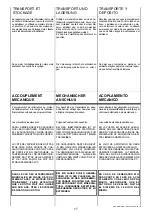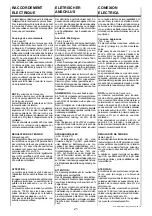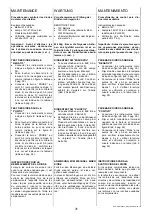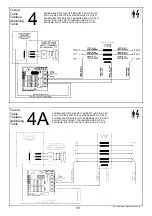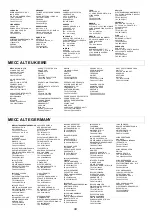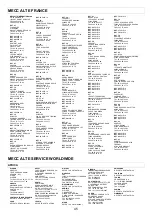
ECO3-N Manual - May 2009 revision 16
MANUTENZIONE
MAINTENANCE
Procedure to check the diodes of the
exciter rotor.
Necessary equipment :
•
12V battery
•
12V-21W lamp (or alternatively 6.8
Ω
-
30W Resistance)
•
Voltmeter (for instance, multimeter
on scale VOLT d.c.)
Warning: before performing the fol-
lowing actions, it is necessaty to di-
sconnect the 2 cables connecting the
main rotor to the diode bridge (+and-)
TEST OF THE DIODES ON THE
“NEGATIVE”
•
Connect the equipment, as it is poin-
ted out in the picture A (table 5 page
39)
•
Fix the cable connected to the lamp
to the negative terminal of the bridge,
as it is pointed out in the picture A
(table 5 page 39)
•
Connect the terminal “Probe” to the
point A1 (it is checked the diode 1),
then to the point A2 (it is checked the
diode 2) and finally to the point A3 (it
is checked the diode 3); check the
readings on the voltmeter in relation
with what is reported on the table
(table 5 page 39).
TEST OF THE DIODES ON THE
“POSITIVE”
•
Connect the equipment, as it is poin-
ted out in the picture B (table 5 page
39)
•
Fix the cable connected to the nega-
tive terminal of the battery to the
positive terminal of the bridge, as it is
pointed out in the picture B (table 5
page 39)
•
Connect the terminal “Probe” to the
point A4 (it is checked the diode 4),
then to the point A5 (it is checked the
diode 5) and finally to the point A6 (it
is checked the diode 6); check the
readings on the voltmeter in relation
with what is reported on the table
(table 5 page 39).
INSTRUCTIONS TO REPLACE
THE DIODE
When the values measured point out a
diode damaged, it is necessary to re-
place the component.
For this purpose it is recommended to
not pull the rheophores out from their
locations, but to cut them near to the
body of the component; then fit in the
new component respecting the polarity
and soft-solder accurately the rheopho-
res with the pieces remained in their
locations.
Procedura di verifica per diodi rotore
eccitatrice.
Strumentazione necessaria :
•
batteria 12V
•
lampada 12V-21W (o in alternativa
resistenza 6.8
Ω
-30W)
•
voltmetro (Ex. Multimetro su scala
VOLT d.c.)
Importante: Prima di eseguire le ope-
razioni seguenti sconnettere i due
cavi di collegamento del rotore prin-
cipale al ponte diodi (+ e -).
TEST DEI DIODI SUL “NEGATIVO”
•
Connettere gli strumenti come indi-
cato in figura A (tabella 5 pag. 39)
•
Fissare il cavo connesso alla lam-
pada al morsetto negativo del ponte
come indicato in figura A (tabella 5
pag. 39)
•
Connettere il terminale “Probe” ai
punti A1, A2 ed A3 in sequenza per
verificare rispettivamente i diodi 1, 2
e 3. Verificare la lettura sul voltmetro
in relazione a quanto indicato in ta-
bella (tabella 5 pag. 39).
TEST DEI DIODI SUL “POSITIVO”
•
Connettere gli strumenti come indi-
cato in figura B (tabella 5 pag. 39)
•
Fissare il cavo connesso al negativo
della batteria al morsetto positivo del
ponte come indicato in figura B
(tabella 5 pag. 39)
•
Connettere il terminale “Probe” ai
punti A4, A5 e A6 in sequenza per
verificare rispettivamente i diodi 4, 5
e 6; verificare la lettura sul voltmetro
in relazione a quanto indicato in ta-
bella (tabella 5 pag. 39).
ISTRUZIONI PER LA SOSTITUZIONE
DEL DIODO.
Qualora i valori riscontrati indichino un
diodo danneggiato, occorrera’ proce-
dere alla sostituzione del componente.
A tale scopo si raccomanda di non
estrarre i reofori dalle rispettive sedi ma
di tagliarli in prossimità del corpo del
componente; inserire il nuovo compo-
nente rispettando le polarità e saldare a
stagno accuratamente i reofori con gli
spezzoni rimasti nelle sedi.
IMPORTANTE
IMPORTANT
WICHTIG
+
-
30


